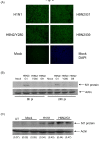Differential replication of avian influenza H9N2 viruses in human alveolar epithelial A549 cells
- PMID: 20334690
- PMCID: PMC2867802
- DOI: 10.1186/1743-422X-7-71
Differential replication of avian influenza H9N2 viruses in human alveolar epithelial A549 cells
Abstract
Avian influenza virus H9N2 isolates cause a mild influenza-like illness in humans. However, the pathogenesis of the H9N2 subtypes in human remains to be investigated. Using a human alveolar epithelial cell line A549 as host, we found that A/Quail/Hong Kong/G1/97 (H9N2/G1), which shares 6 viral "internal genes" with the lethal A/Hong Kong/156/97 (H5N1/97) virus, replicates efficiently whereas other H9N2 viruses, A/Duck/Hong Kong/Y280/97 (H9N2/Y280) and A/Chicken/Hong Kong/G9/97 (H9N2/G9), replicate poorly. Interestingly, we found that there is a difference in the translation of viral protein but not in the infectivity or transcription of viral genes of these H9N2 viruses in the infected cells. This difference may possibly be explained by H9N2/G1 being more efficient on viral protein production in specific cell types. These findings suggest that the H9N2/G1 virus like its counterpart H5N1/97 may be better adapted to the human host and replicates efficiently in human alveolar epithelial cells.
Figures



Similar articles
-
H9N2 influenza viruses possessing H5N1-like internal genomes continue to circulate in poultry in southeastern China.J Virol. 2000 Oct;74(20):9372-80. doi: 10.1128/jvi.74.20.9372-9380.2000. J Virol. 2000. PMID: 11000205 Free PMC article.
-
The neuraminidase inhibitor GS4104 (oseltamivir phosphate) is efficacious against A/Hong Kong/156/97 (H5N1) and A/Hong Kong/1074/99 (H9N2) influenza viruses.Antiviral Res. 2000 Nov;48(2):101-15. doi: 10.1016/s0166-3542(00)00123-6. Antiviral Res. 2000. PMID: 11114412
-
H9N2 influenza viruses prevalent in poultry in China are phylogenetically distinct from A/quail/Hong Kong/G1/97 presumed to be the donor of the internal protein genes of the H5N1 Hong Kong/97 virus.Avian Pathol. 2003 Oct;32(5):551-60. doi: 10.1080/0307-9450310001596728. Avian Pathol. 2003. PMID: 14522712
-
Human-infecting influenza A (H9N2) virus: A forgotten potential pandemic strain?Zoonoses Public Health. 2020 May;67(3):203-212. doi: 10.1111/zph.12685. Epub 2020 Jan 12. Zoonoses Public Health. 2020. PMID: 31930694 Review.
-
H9N2 influenza virus in China: a cause of concern.Protein Cell. 2015 Jan;6(1):18-25. doi: 10.1007/s13238-014-0111-7. Epub 2014 Nov 11. Protein Cell. 2015. PMID: 25384439 Free PMC article. Review.
Cited by
-
Gene expression signature-based screening identifies new broadly effective influenza a antivirals.PLoS One. 2010 Oct 4;5(10):e13169. doi: 10.1371/journal.pone.0013169. PLoS One. 2010. PMID: 20957181 Free PMC article.
-
Investigation of influenza virus polymerase activity in pig cells.J Virol. 2013 Jan;87(1):384-94. doi: 10.1128/JVI.01633-12. Epub 2012 Oct 17. J Virol. 2013. PMID: 23077313 Free PMC article.
-
A single E627K mutation in the PB2 protein of H9N2 avian influenza virus increases virulence by inducing higher glucocorticoids (GCs) level.PLoS One. 2012;7(6):e38233. doi: 10.1371/journal.pone.0038233. Epub 2012 Jun 13. PLoS One. 2012. PMID: 22719870 Free PMC article.
-
Assessing the fitness of distinct clades of influenza A (H9N2) viruses.Emerg Microbes Infect. 2013 Nov;2(11):e75. doi: 10.1038/emi.2013.75. Epub 2013 Nov 6. Emerg Microbes Infect. 2013. PMID: 26038443 Free PMC article.
-
Differential replication properties among H9N2 avian influenza viruses of Eurasian origin.Vet Res. 2015 Jul 6;46(1):75. doi: 10.1186/s13567-015-0198-8. Vet Res. 2015. PMID: 26149130 Free PMC article.
References
-
- Xu KM, Smith GJ, Bahl J, Duan L, Tai H, Vijaykrishna D, Wang J, Zhang JX, Li KS, Fan XH, Webster RG, Chen H, Peiris JS, Guan Y. The genesis and evolution of H9N2 influenza viruses in poultry from southern China, 2000 to 2005. J Virol. 2007;81:10389–10401. doi: 10.1128/JVI.00979-07. - DOI - PMC - PubMed
-
- Lin YP, Shaw M, Gregory V, Cameron K, Lim W, Klimov A, Subbarao K, Guan Y, Krauss S, Shortridge K, Webster R, Cox N, Hay A. Avian-to-human transmission of H9N2 subtype influenza A viruses: relationship between H9N2 and H5N1 human isolates. Proc Natl Acad Sci USA. 2000;97:9654–9658. doi: 10.1073/pnas.160270697. - DOI - PMC - PubMed
Publication types
MeSH terms
Substances
LinkOut - more resources
Full Text Sources

